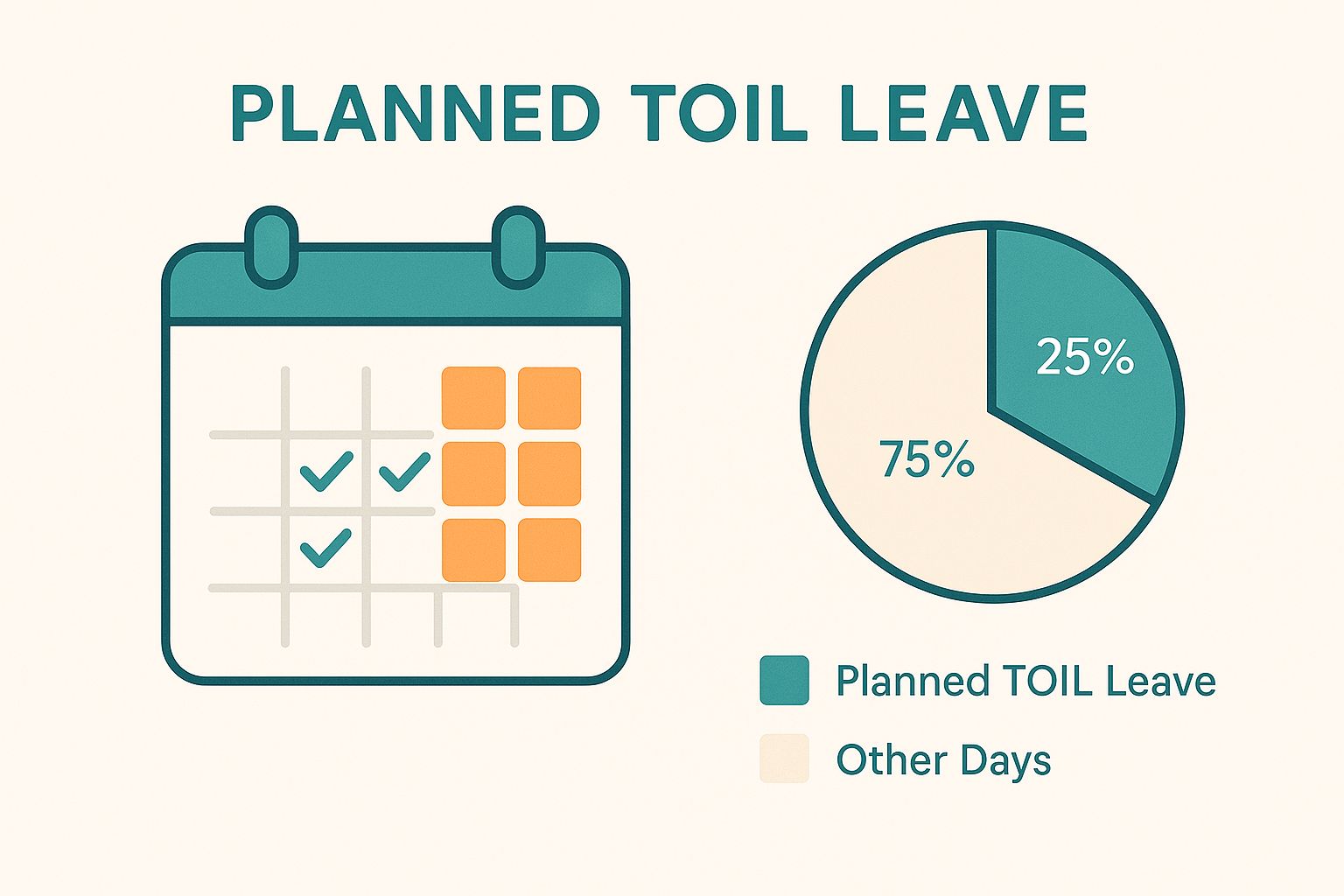What Is Toil Leave Your UK Guide

TOIL leave is pretty straightforward: it’s paid time off you get for working extra hours, instead of being paid overtime for them. Think of it like a time bank. You 'deposit' the extra hours you put in during a busy period, then 'withdraw' them later as a well-earned day off.
What TOIL Really Means for Your Work Life

At its heart, Time Off In Lieu (TOIL) is a formal deal that offers a great alternative to standard overtime pay. When you find yourself working beyond your normal hours—maybe to hit a tight project deadline or to help out when a colleague is off sick—a TOIL system lets you bank that extra time.
This arrangement is built on a simple trade-off: your extra graft today becomes your downtime tomorrow. Instead of seeing a bit more cash in your payslip, you get something just as valuable—your own time back.
The Foundation of a TOIL Agreement
It's really important to know that TOIL isn't an automatic legal right in the UK. The whole system relies on a mutual agreement between you and your employer. This should always be clearly set out in your employment contract or a specific company policy. You can read more about how this optional arrangement works on rotacloud.com.
This pre-agreed framework is what keeps TOIL fair and transparent. It makes sure everyone knows the rules—from how you earn the hours to when you can take them—which helps avoid any confusion or disagreements later on.
Key Features at a Glance
To give you a quick snapshot, here’s a simple breakdown of the fundamental parts that make up a typical TOIL system. These elements are the building blocks of any solid TOIL policy, providing clarity for both employees and the business.
TOIL at a Glance: Key Features Explained
| Aspect | Explanation |
|---|---|
| Voluntary Agreement | TOIL is not a legal requirement; it must be mutually agreed upon and detailed in a contract or policy. |
| Alternative to Overtime Pay | Instead of financial compensation for extra hours, employees earn time off. |
| Accrual Rate | This defines how time is earned. Often, it's a 1:1 ratio (one extra hour worked equals one hour of TOIL). |
| Usage Window | Policies usually specify a timeframe in which accrued TOIL must be used, such as within 3 or 6 months. |
| Approval Process | Taking TOIL leave typically requires manager approval, similar to booking annual leave. |
| No Cash Value (Usually) | In most cases, unused TOIL is not paid out when an employee leaves the company, unless specified. |
Having these components clearly defined from the start is what makes a TOIL scheme work smoothly and effectively for everyone involved.
Navigating the Legal Side of TOIL in the UK

While there’s no law that says a UK employer must offer TOIL, it doesn't operate in a legal vacuum either. Any TOIL scheme needs to play by the rules, and the main rulebook here is the Working Time Regulations 1998.
These regulations are the reason we have limits on working hours. The big one? Most employees can't work more than an average of 48 hours per week, which is usually calculated over a 17-week period.
This is where a good TOIL system comes in handy. It’s a smart way for a business to navigate busy spells without having to get every team member to sign an opt-out agreement for the 48-hour week.
Why a Written Policy Is Non-Negotiable
A casual, "we'll sort it out later" approach to TOIL is just asking for trouble. To protect everyone involved—both the company and its staff—you absolutely need a clear, written TOIL policy that’s included in the employment contract.
Having it all down in black and white removes any guesswork. Everyone knows exactly where they stand from day one, creating a solid, legally sound framework that stops disagreements before they even start.
Think of a formal policy as your single source of truth. It sets the ground rules for earning and taking time off, making sure the process is fair and consistent for the whole team.
For example, a rock-solid policy should clearly state:
- How TOIL is earned: What's the accrual rate? Is it a straight hour-for-hour swap (1:1) or a premium rate like time-and-a-half (1.5:1)?
- When it expires: TOIL can't be stockpiled forever. Set a reasonable deadline for when it needs to be used.
- What happens when someone leaves: Does an employee get paid for their unused TOIL, or is it forfeited? This needs to be crystal clear.
One final, critical point to watch is the National Minimum Wage. The total hours someone works, including any unpaid overtime that's being converted into TOIL, can't push their average hourly pay below the legal minimum for that pay period. It's a crucial legal check that any well-run TOIL system has to account for.
While TOIL is separate from your holiday allowance, it's always a good idea to be clear on your core entitlements. You can learn more about your UK holiday rights in our guide to statutory annual leave.
Weighing the Pros and Cons of a TOIL Policy
Deciding whether to roll out a Time Off In Lieu (TOIL) system isn't always straightforward. It's about weighing up the very real benefits against some potential pitfalls. For many businesses, a well-managed TOIL policy is a brilliant way to handle the natural ebb and flow of work without ballooning the payroll.
The biggest win? Flexibility. Instead of paying out costly overtime rates during a crunch project, you can offer your team time off during a quieter spell. It's a practical way to manage budgets while still hitting those important deadlines. It's a popular approach for a reason, with research showing that 30-40% of UK businesses use TOIL to manage busy periods without inflating wage costs. You can dig deeper into these findings on TOIL policy usage.
This infographic gives a great visual of how a TOIL system can empower employees to plan their time off, slotting their earned leave into their schedule when it suits them best.

As you can see, TOIL gives people a concrete way to schedule a breather after an intense period of work, which is a massive plus for a healthy work-life balance.
Benefits for Employees
From the employee's perspective, the main draw is having more control over their own time. The chance to bank extra hours and cash them in for a long weekend, a doctor's appointment, or a child's school play is a genuinely valuable perk. It just makes juggling life's demands that little bit easier.
This kind of flexibility can do wonders for morale and job satisfaction. When staff see their extra effort rewarded with something as precious as time, they feel trusted and respected. It’s a powerful motivator.
Potential Downsides to Consider
But, it's not all plain sailing. The biggest headache with TOIL is often the admin. Without a rock-solid, easy-to-use system, tracking who's owed what can become a nightmare for managers and HR, opening the door to mistakes and disagreements.
There's also the very real risk of burnout. If team members are racking up huge amounts of TOIL without any real chance to take it, the system is broken. It can end up normalising a culture of overwork, which is the exact opposite of what you want. Unclear rules on when and how to use banked time can quickly lead to frustration all around.
To get a clearer picture, let's break down how a TOIL policy impacts both sides of the coin.
TOIL Policy Comparison Advantages vs Disadvantages
| Perspective | Advantages of TOIL | Disadvantages of TOIL |
|---|---|---|
| Employer | Cost-Effective: Avoids paying premium overtime rates, helping to manage the wage bill. | Admin Burden: Can be complex and time-consuming to track accurately without a proper system. |
| Resource Management: Provides flexibility to manage staffing during fluctuating workloads and deadlines. | Operational Disruption: If multiple employees take their TOIL at once, it can lead to understaffing. | |
| Improved Morale: Can be seen as a positive perk, boosting team satisfaction and retention. | Risk of Misuse: Without clear guidelines, the policy can be applied inconsistently. | |
| Employee | Greater Flexibility: Offers more control over personal time for appointments, family, or longer weekends. | Risk of Burnout: Accumulated TOIL can be a sign of chronic overwork if it can't be taken. |
| Fair Recognition: Extra hours worked are formally acknowledged and compensated with time. | Delayed Reward: The benefit isn't immediate like overtime pay, and taking the time off can be difficult. | |
| Work-Life Balance: Provides a tangible way to rest and recover after intense periods of work. | Potential for Conflict: Unclear rules or pressure not to take TOIL can lead to frustration. |
Ultimately, a successful TOIL system hinges on having a crystal-clear policy and a simple way to manage it. When done right, it's a win-win, but without that foundation, it can cause more problems than it solves.
How to Build and Manage a Fair TOIL System
Let's be honest, a successful TOIL system boils down to one simple thing: clarity. A vague, "we'll sort it out later" approach is just asking for confusion and resentment down the line. To get this right, you need a formal, transparent policy that everyone understands from day one.
The bedrock of any good TOIL system is its rules. Think of them as the agreed-upon terms that keep everything fair and consistent for the whole team. Without them, what’s meant to be a benefit can quickly turn into a source of major frustration.
Setting Clear Policy Guidelines
Before you can even think about managing TOIL, you have to define it for your business. Your policy needs to be the go-to guide, answering any question an employee might have before they even have to ask. Getting ahead of this prevents simple misunderstandings and makes sure the system is applied the same way for everyone.
Your policy absolutely must cover:
- The Approval Process: All overtime must be pre-approved by a manager to count towards TOIL. This is non-negotiable. It stops TOIL from spiralling out of control and helps you keep a handle on workloads.
- The Accrual Ratio: Be crystal clear on how TOIL is earned. Is it a straightforward 1:1 ratio, where one hour of overtime equals one hour of leave? Or will you offer something more, like time-and-a-half?
- An Accrual Cap: Put a sensible limit on the number of TOIL hours someone can save up. This is vital for preventing employee burnout and avoiding a nightmare scenario where people have accumulated unmanageable amounts of leave.
- Expiry Dates: TOIL shouldn’t sit on the books forever. Specify a reasonable timeframe for it to be used, like within three or six months. This nudges people to actually take the breaks they’ve earned.
A well-defined policy isn’t about being restrictive; it’s about creating a system that’s predictable and fair. When your team sees that the rules apply equally to everyone, they trust the process and feel properly valued.
Choosing the Right Tracking Method
Once your rules are in place, you need a bulletproof way to track everything. Relying on scribbled notes or memory is a recipe for disaster. Manual methods get messy fast, leading to mistakes and lost records. The goal is a tracking system that's simple, accurate, and easy for both employees and managers to use.
If you’re a tiny startup, a shared spreadsheet might get you by for a while. But as soon as your team starts to grow, that approach becomes a real headache.
The best long-term solution is dedicated software. Using a proper tool automates the whole process, from logging the extra hours worked right through to approving the time off. If you're wondering what's out there, our guide to online leave management systems is a great place to start exploring how they can make your life easier.
Putting TOIL into Practice: Everyday Scenarios
So, we've covered the basics of TOIL, but what does it actually look like day-to-day? Knowing the rules is one thing; seeing how they play out in real-life situations is where it all clicks. Let's walk through a couple of common examples.
A Weekend Project
Picture this: Sarah, a marketing executive, has a massive campaign launch on the horizon. To get everything over the line, she needs to put in some serious hours over the weekend.
Under her company's TOIL policy, the first step isn't just to start working. She first gets written approval from her manager via email. This simple step creates a clear, official record before she works a single extra minute.
After putting in 12 hours over Saturday and Sunday, Sarah logs that time on the company’s HR platform. Her manager quickly verifies and approves it, and just like that, 12 hours are added to her TOIL balance. This kind of transparent, immediate tracking is brilliant because it stops any potential disputes before they can even start.
Cashing in That Hard-Earned Time
A few weeks later, the campaign is a roaring success, and Sarah fancies a long weekend to recharge. She pops a leave request into the same system, but instead of deducting it from her annual leave, she simply selects 'TOIL' as the reason.
Her manager sees the request, notes there are no clashing deadlines, and gives it the green light. The system automatically updates her balance.
The big lesson here is that a clear, consistent process is everything. When requests, approvals, and tracking are all documented, it removes any grey areas and builds trust. Everyone knows where they stand.
What About Trickier Situations?
Of course, it’s not always that straightforward. What happens if an employee leaves the company with a bank of TOIL hours? A well-thought-out policy will have this covered. It should state clearly whether those hours are paid out in their final pay, must be used up during their notice period, or are forfeited. Getting this down in writing prevents awkward, and often difficult, conversations when someone is on their way out.
Honestly, for most businesses, trying to manage all this with a jumble of spreadsheets just doesn't cut it. To keep things fair and avoid disputes, using the best employee clocking in system makes a world of difference. It automates everything from logging overtime to managing leave balances, saving a ton of admin time and making sure every single hour is accounted for properly.
Got Questions About TOIL? We’ve Got Answers.
When it comes to Time Off In Lieu, the devil is often in the details. It's one of those workplace policies that can throw up a lot of "what if" scenarios. So, let’s clear the air and tackle some of the most common questions that pop up for both employees and managers in the UK.
Think of this as your practical guide to navigating the specifics.
Can My Employer Make Me Take TOIL Instead of Overtime Pay?
In short, no. An employer can't force you to take TOIL if your contract already promises you paid overtime. The whole system hinges on mutual agreement.
This agreement needs to be spelled out clearly, either in your main employment contract or a separate company-wide policy. If your contract is silent on the matter, any arrangement for working extra hours has to be agreed upon by both you and your employer – it can't just be imposed on you.
What Happens to My Accrued TOIL If I Leave My Job?
This is a classic question, and the answer lies entirely in your company's TOIL policy. A well-thought-out policy will have a clear clause explaining what happens to your banked hours when you hand in your notice.
A clear policy is your best friend here. It should state whether you're expected to use up your TOIL during your notice period, whether the hours will be paid out in your final pay packet, or if, in some cases, they are forfeited. Without this in writing, it can easily turn into a messy dispute.
Is There a Limit on How Much TOIL I Can Build Up?
Yes, and there absolutely should be. Most companies cap how much TOIL an employee can accumulate, and it’s a smart move for everyone involved. Setting a limit is a best practice for a couple of big reasons.
First, it stops people from hoarding huge amounts of leave, which can be a red flag for overwork and potential burnout. Second, it helps the business manage its resources, preventing a situation where half the team is suddenly owed weeks of extra holiday. The specific cap should always be clearly stated in the TOIL policy.
Does TOIL Expire?
It's very common for TOIL to come with an expiry date, and frankly, it's a good idea. This is a key feature that keeps the system fair and manageable.
For instance, a policy might say that TOIL must be used within three months of being earned. This encourages people to actually take the time off they're owed, which is crucial for resting and recharging. It also protects the company from the operational headache of everyone trying to use up a massive backlog of leave at the same time.
Trying to manage TOIL, track everyone's balances, and keep it all fair can feel like a full-time job. With Annual Leave Tracker, you can automate the entire process – from logging extra hours to approving the time off. It's all handled in one simple, clear system. Find out how Annual Leave Tracker can streamline your absence management today.
Ready to Transform Your Leave Management?
Join 500+ companies using Annual Leave Tracker to streamline their HR processes.


